
|   |

|   |
 e-mail: ukb7@rediffmail.com Odissi's breath of fresh air Photos courtesy: Shinjan Nrityalaya June 24, 2021 As a heritage classical dance of India, Odissi offers some interesting parallels with the other most popular classical style of Bharatanatyam. If the latter draws inspiration from the Chola sculptures of the temples like Brihadishwara at Tanjavur, Gangaikondacholapuram and Nataraja temple at Chidambaram, all of 10th century, Odissi has similar heritage reliefs and grottos at Mukteshwar temple in Bhubaneswar of 10th century and Konark temple of 13th century. Both traditional forms fell into disrepute later, and remained neglected over a long period. If the lawyer E Krishna Iyer was responsible for a resolution favoring Bharatanatyam at Madras Music Academy in 1932, his undertaking sustained training in that form and making Rukmini Devi Arundale witness a performance in 1935 that led to the resurrection of the form, it was the biologist Priyambada Mohanty's dance at a Delhi student convention in 1954, followed by the noted columnist Charles Fabri's warm accolades that led to "rediscovery" of Odissi. Just as Rukmini Devi's institutionalized effort along with reputed gurus led to the full-fledged revival of Bharatanatyam, it was the teachers' and gurus' organized teamwork at the 'Jayantika' conclave around 1959 that led to Odissi attaining its present rich and flourishing form. There have been remarkable generational leaps since. Speaking of Odissi, the pioneering gurus like Debaprasad Das, Kelucharan Mohapatra, Pankaj Charan Das, Mayadhar Raut and a host of others handed over their batons to their dedicated disciples from the next generation, not only to carry forward the tradition, but also to add new items of Pallavi, Abhinaya, Moksha and other segments to enrich the repertoire. And today, one is noticing the emergence of the gifted "gen. next" who are taking over the cudgels. Parampara - A Classical Dance Festival, with Odissi presentation organized online by Shinjan Nrityalaya, under the patronage of the Ministry of Culture and EZCC, presented a bevy of bright young third generation dancers on June 17, the first day. Directed by the noted Odissi dancer Aloka Kanungo, there could be no better curtain raiser than the svelte Arushi Mudgal, a Delhi based disciple of Madhavi Mudgal (holding the legacy of legendary Kelubabu). Already holding the SNA's Bismillah Khan Yuva Puraskar and named among the ten best Odissi dancers of India by New York Times, Arushi had the distinction of having performed before Presidents and Prime Minister at Rashtrapati Bhavan, and notably before Barak Obama. Arushi presented the Gita Govinda ashtapadi Yahi Madhava, Yahi Keshava... a favorite piece of Madhavi etched in one's mind for the intense mix of derision as well as desire evinced by Radha until she moves out of Krishna's presence. It goes to Arushi's hard earned credit that she had nearly the same depth of feelings and yearnings - as her guru had -- right up to the end of the abhinaya. 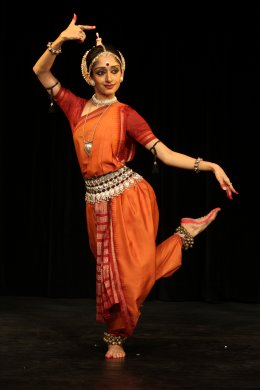 Arushi Mudgal 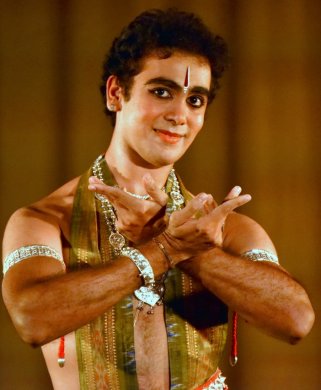 Aneesh Raghavan Aneesh Raghavan, a Puducherry based disciple of Sangeeta Dash, was the second young dancer. Recipient of CCRT scholarship and winner of Margazhi Festival's top award, Aneesh had performed in many festivals in India and abroad in Europe, Middle East and Far East, and had also the distinction of being a Sanskrit scholar. Quite appropriately, Aneesh chose an excerpt Ashadasys prathama divase, megham ashlista sanum... from Kalidasa's epic verse Ritusamharam with choreography by his guru in Pallavi style, music by Ramahari Das, rhythms by Dhaneswar Swain and special effects by Jeffrey Emanuel and Priscilla Shiny. Aneesh had a good stage presence and impressive physique, and his hasta mudras and charis were beautifully executed. His shringara of the Abhisarika Nayika in the thick of the downpours - when the Rain God sprinkled water with thunderstorms and peacocks danced at the sight of clouds -- was also well done. But he should be wary of the temptation of doing mostly feminine stances (when such a good role model was available in Ramli Ibrahim from Sutra Dance, Malaysia). Nivedita Daw, a Kolkata based disciple of Aloka Kanungo of Kelubabu gharana was the third artist. A senior dancer and a national scholar under Ministry of Culture and with considerable experience of the Indian festivals and wide international exposure, Nivedita had a very attractive stage presence. She chose the well-known Kelubabu composition Nachanti range Srihari... in raga Arvi and tala Ekatali, where Gopis played veena, mardala and manjeera, accompanied by different ragas. It was a well done bravura performance. With her pretty face and attractive countenance, her angika abhinaya had the unmistakable Kelubabu stance, but her sattvika bhava needed some more attention to the ranga (playful) aspect of the dance she depicted, with more visible enjoyment of the frolic and the fanfare. 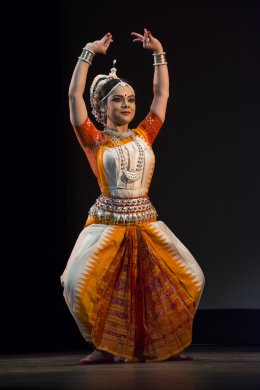 Nivedita Daw 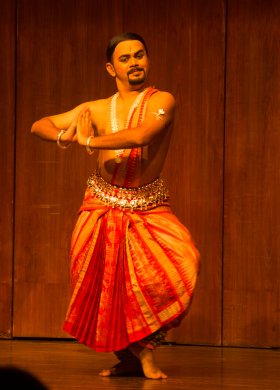 Ankur Ballal Ankur Ballal, Mumbai based dancer, with guru Jhelum Paranjape, bore the lineage of Kelubabu, followed by Ratikant and Sujata Mohapatra, and was the fourth artist to come up on the platform. He had studied in Gandharva Mahavidyalaya as well and had won much encomium on the Mumbai stage, with extensive performance exposure in multiple festivals. Ankur took up Dasa Mahavidya choreographed by Aloka Kanungo as Sabda Nritya with music by Ramahari Das and Dhaneswar Swain, set in Ragamalika and talamalika. The Dasa Mahavidya (Shakti) comprise Kali, Tara, Tripura Sundari (Shodashi), Bhuvaneswari, Tripura Bhairavi, Chhinnamasta, Dhumavati, Bagalamukhi, Matangi and Kamala. The dance was in two segments, depiction of the first four goddesses and a sloka in praise of all the ten deities.The depiction needed attention and skills to alternate between Shubhankari (benevolent) and Bhayankari (malevolent) aspects of the goddess Shakti in ten manifestations. Perhaps the choreography could make them distinctly apart from each other. Ankur was appropriately virile and masculine, emphasizing tandava in his abhinaya. Vrinda Chadha, Delhi based disciple of Ranjana Gauhar (of Mayadhar Raut vintage), was the fifth dancer, having won national scholarship under Min. of Culture and having had a lot of dancing experience with her guru touring Spain, Argentina, UK and East Asian countries. She chose as her first dance, an ode to Tripura Sundari, a benevolent Mahavidya. With a good figure and excellent stage presence, she did ample justice to the theme in her lasya. Both nritta and abhinaya were executed by her with considerable prowess. Her second item was a lullaby by the 16th century blind saint-poet Surdas, Paalane jhula de Yashoda Hari.... Written in Brajbhasha, the verse described affectionate swinging of the baby Krishna on a jhula. The young mother's role suited her well trying to get away to her domestic chores and her falling asleep at the end after the baby rested, lending quite a charming touch. Both items were choreographed by her guru. 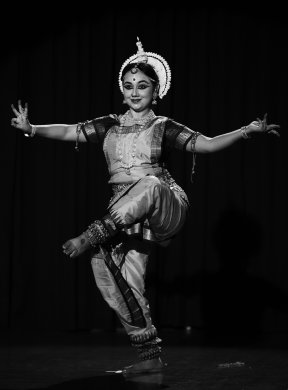 Vrinda Chadha 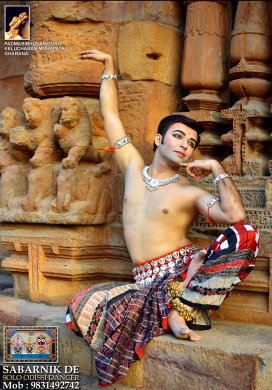 Sabarnik De 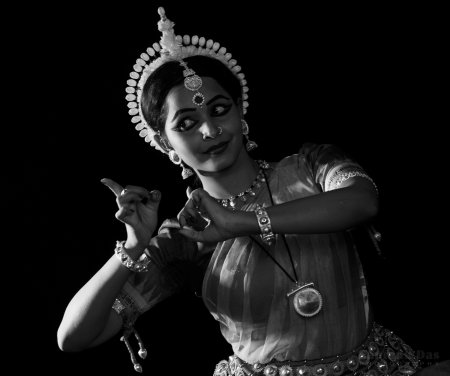 Puja Jena The grand finale was etched by Bhubaneswar based Puja Jena, disciple of Aruna Mohanty (of Guru Srinath Raut vintage). At a relatively young age, she had performed in many festivals and travelled around the globe to UK, USA, UAE and Far Eastern countries as a member of her guru's Orissa Dance Academy. She selected a traditional Oriya song Bajucchi sakhi bajare... with choreography by Guru Gangadhar Pradhan and music by Bijaya Kumar Jena. The song narrated the hearsay brought by the companion to Radha that everybody had become aware of her love for Krishna and that there was gossip all around! Puja had a very pleasant countenance and her abhinaya was captivating all through, including a charming interlude where Radha goes for a wash in the Yamuna waters, imagines Krishna's visage there and comes away determined to defy all social norms for the sake of her mon amour. Warts and all, the brigade of seven talented youngsters proved the point that Odissi was in excellent hands with the new generation and would go from glory to glory, as it is already doing alongside Bharatanatyam, with no less popularity in India and overseas.  Dr. Utpal K Banerjee is a scholar-commentator on performing arts over last four decades. He has authored 23 books on Indian art and culture, and 10 on Tagore studies. He served IGNCA as National Project Director, was a Tagore Research Scholar and is recipient of Padma Shri. Post your comments Pl provide your name and email id along with your comment. All appropriate comments posted with name and email id in the blog will also be featured in the site. |